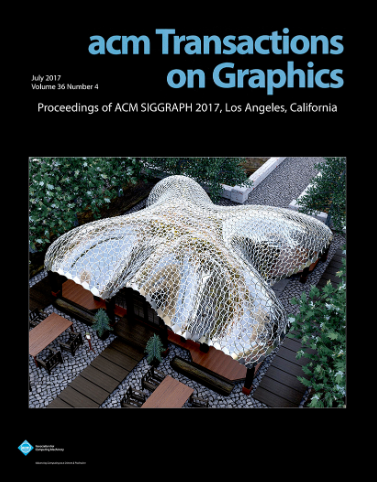直接操纵程序隐含曲面
IF 9.5
1区 计算机科学
Q1 COMPUTER SCIENCE, SOFTWARE ENGINEERING
引用次数: 0
摘要
程序化隐式曲面是一种常用的形状建模表示方法。它们为布尔运算、混合和变形等复杂的几何操作提供了一个简单的框架。然而,它们的可编辑性仍然是一项具有挑战性的任务:由于形状的定义是纯隐式的,因此无法对形状进行直接操作。因此,模型的参数通常通过抽象的滑动条来显示,而这些滑动条必须由用户创建,并由其他人理解,才能对每个模型进行修改。此外,每个滑块都需要逐个设置,以达到所需的外观效果。为了避免这一费力的过程,同时保留可编辑性,我们建议在视口中直接操作隐式曲面。我们让用户与输出形状自然交互,利用我们专门为隐式曲面设计的共参数化点来引导参数更新,从而更快地达到所需的外观效果。我们利用程序化隐式曲面的自动区分功能,将用户在视口中进行的交互传播到形状参数本身。我们进一步设计了一个求解器,利用这些信息来引导直观流畅的用户工作流程。我们在多个隐式形状和参数上演示了不同的编辑流程,而这些流程通过调整滑块是非常繁琐的。本文章由计算机程序翻译,如有差异,请以英文原文为准。
Direct Manipulation of Procedural Implicit Surfaces
Procedural implicit surfaces are a popular representation for shape modeling. They provide a simple framework for complex geometric operations such as Booleans, blending and deformations. However, their editability remains a challenging task: as the definition of the shape is purely implicit, direct manipulation of the shape cannot be performed. Thus, parameters of the model are often exposed through abstract sliders, which have to be nontrivially created by the user and understood by others for each individual model to modify. Further, each of these sliders needs to be set one by one to achieve the desired appearance. To circumvent this laborious process while preserving editability, we propose to directly manipulate the implicit surface in the viewport. We let the user naturally interact with the output shape, leveraging points on a co-parameterization we design specifically for implicit surfaces, to guide the parameter updates and reach the desired appearance faster. We leverage our automatic differentiation of the procedural implicit surface to propagate interactions made by the user in the viewport to the shape parameters themselves. We further design a solver that uses such information to guide an intuitive and smooth user workflow. We demonstrate different editing processes across multiple implicit shapes and parameters that would be tedious by tuning sliders.
求助全文
通过发布文献求助,成功后即可免费获取论文全文。
去求助
来源期刊

ACM Transactions on Graphics
工程技术-计算机:软件工程
CiteScore
14.30
自引率
25.80%
发文量
193
审稿时长
12 months
期刊介绍:
ACM Transactions on Graphics (TOG) is a peer-reviewed scientific journal that aims to disseminate the latest findings of note in the field of computer graphics. It has been published since 1982 by the Association for Computing Machinery. Starting in 2003, all papers accepted for presentation at the annual SIGGRAPH conference are printed in a special summer issue of the journal.
 求助内容:
求助内容: 应助结果提醒方式:
应助结果提醒方式:


